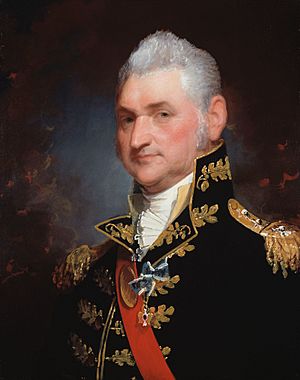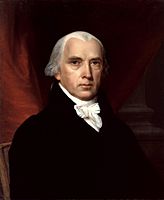Henry Dearborn facts for kids
Quick facts for kids
Henry Dearborn
|
|
|---|---|
 |
|
| 5th United States Secretary of War | |
| In office March 5, 1801 – March 4, 1809 |
|
| President | Thomas Jefferson |
| Preceded by | Samuel Dexter |
| Succeeded by | William Eustis |
| 7th United States Minister to Portugal | |
| In office August 16, 1822 – June 30, 1824 |
|
| President | James Monroe |
| Preceded by | John Graham |
| Succeeded by | Thomas L. L. Brent |
| 10th Senior Officer of the United States Army | |
| In office January 27, 1812 – June 15, 1815 |
|
| President | James Madison |
| Preceded by | James Wilkinson |
| Succeeded by | Jacob Brown |
| Member of the U.S. House of Representatives from Massachusetts |
|
| In office March 4, 1793 – March 3, 1797 Serving with Peleg Wadsworth and George Thatcher (1793–95)
|
|
| Preceded by | Theodore Sedgwick |
| Succeeded by | Isaac Parker |
| Constituency | 4th district (1793–95) 12th district (1795–97) |
| Personal details | |
| Born | February 23, 1751 North Hampton, New Hampshire, British America |
| Died | June 6, 1829 (aged 78) Roxbury, Massachusetts, U.S. |
| Political party | Anti-Administration (Before 1792) Democratic-Republican (1792–1829) |
| Signature | |
| Military service | |
| Allegiance | |
| Branch/service | |
| Years of service | 1775–1783 1812–1815 |
| Rank | |
| Battles/wars | American Revolutionary War War of 1812 |
Henry Dearborn (born February 23, 1751 – died June 6, 1829) was an important American military officer and politician. He played a big part in the early history of the United States.
During the American Revolutionary War, he fought bravely under famous leaders like Benedict Arnold and George Washington. His detailed journal from the expedition to Quebec is a valuable record of that time. After the war, he continued to serve his country. He became the United States Secretary of War under President Thomas Jefferson from 1801 to 1809. Later, he was a commanding general in the War of 1812. Many places, like Fort Dearborn in Illinois and the city of Dearborn, Michigan, are named in his honor.
Contents
Who Was Henry Dearborn?
Early Life and Family
Henry Dearborn was born on February 23, 1751, in North Hampton, New Hampshire. His parents were Simon Dearborn and Sarah Marston. His family had come to America from England in 1639.
Henry grew up in Epping, New Hampshire, where he went to public schools. He was a very athletic and strong boy, known as a champion wrestler. He studied medicine and became a doctor in 1772.
Henry Dearborn was married three times. His son, Henry Alexander Scammell Dearborn, was also an important figure later on.
Fighting in the Revolutionary War
When the American Revolutionary War began, Henry Dearborn joined the fight. He started as a captain in the New Hampshire Regiments. He quickly rose through the ranks to become a lieutenant colonel.
He fought in the Battle of Bunker Hill in June 1775. He led a group of sixty local militia men. He noted that the soldiers were not in uniform, but in their everyday clothes.
Dearborn volunteered for a difficult expedition to Quebec in September 1775. He served under Colonel Benedict Arnold. His journal from this journey gives us important details about the challenges they faced. He wrote, "We were small indeed to think of entering a place like Quebec. But being now almost out of provisions we were sure to die if we attempted to return back and we could be in no worse situation if we proceeded on our rout."
During the attack on Quebec, Dearborn was captured by the British. He was held for about a year before being released. After his release, he continued to fight. He was at the Battle of Ticonderoga in 1777. He also fought in the Battle of Saratoga, a very important victory for the Americans.
Later, he joined General George Washington's main army at Valley Forge in Pennsylvania. He spent the cold winter of 1777–1778 there. He also fought at the Battle of Monmouth in New Jersey in 1778.
In 1781, Dearborn joined Washington's staff again. He was a deputy quartermaster general. This meant he helped manage supplies for the army. He also commanded the 1st New Hampshire at the siege of Yorktown. He was there when the British General Cornwallis surrendered. This was a major turning point in the war.
After the war, in 1783, Dearborn moved to Gardiner, Maine. He became a Major General in the Maine militia. President Washington later appointed him as a marshal for the District of Maine. He also served in the United States House of Representatives from 1793 to 1797.
Serving the Nation

In 1801, President Thomas Jefferson chose Henry Dearborn to be his United States Secretary of War. Dearborn held this important job for eight years. As Secretary of War, he helped Jefferson create new laws for the military. He also helped establish the military academy at West Point. This school trains future military leaders.
Dearborn and Jefferson often wrote to each other about military and political issues. Dearborn helped shape the government's policy toward Native Americans. The goal was to set clear boundaries and acquire lands along the Mississippi River.
He also played a role in the events surrounding the Burr conspiracy. This was a plan by Aaron Burr and James Wilkinson that some believed aimed to create a new country in the Southwest. Dearborn was cautious and warned Wilkinson about his association with Burr.
In 1809, President James Madison appointed Dearborn as the collector of the port of Boston. He held this job until 1812. Then, he was appointed as the Commanding General of the United States Army.
The War of 1812

During the War of 1812, Henry Dearborn was given command of the northeastern part of the country. This area stretched from the Niagara River to the New England coast. President Madison trusted Dearborn because of his experience in the Revolutionary War.
However, by this time, Dearborn was 61 years old. He was not as quick or confident as he used to be. He found it hard to inspire his troops. He also had trouble getting the New England militias to join the fight.
Dearborn planned attacks on several Canadian locations, including Montreal and Kingston. But these plans did not always go well. For example, a planned attack into Lower Canada in November 1812 failed. Some historians also believe he was too slow to send troops to defend Detroit. Detroit was surrendered to the British without a fight.
Despite these challenges, Dearborn did have some successes. In April 1813, American forces under Dearborn captured York (now Toronto). They also captured Fort George in May 1813. However, his overall command was seen as not very effective. He was removed from his command in July 1813. He was then given an administrative role in New York City.
Dearborn was honorably discharged from the Army in June 1815.
Later Years and Legacy
After his military career, Henry Dearborn remained active. He was a founding member of the Society of the Cincinnati. This society was for officers who had served in the Continental Army. He also became a member of the American Antiquarian Society in 1816. This is the oldest historical society in the United States.
In 1818, Dearborn ran for Governor of Massachusetts. During his campaign, he wrote an article about the Battle of Bunker Hill. In it, he criticized General Israel Putnam's actions during the battle. This caused a big disagreement among war veterans and historians.
President James Monroe later appointed Dearborn as the United States Ambassador to Portugal. He served in this role from 1822 to 1824. He then asked to be recalled and retired.
Henry Dearborn passed away on June 6, 1829, at his home in Roxbury, Massachusetts. He is buried in Forest Hills Cemetery in Boston.
Many places in the United States are named after Henry Dearborn. The Lewis and Clark Expedition named the Dearborn River in Montana after him in 1803. Dearborn County, Indiana, and the cities of Dearborn, Michigan, and Dearborn, Missouri, also bear his name. Fort Dearborn in Chicago was named for him, and a major street in downtown Chicago, Dearborn Street, is named after the fort.
His daughter, Augusta Dearborn, is the namesake for the city of Augusta, Maine. During World War II, a coastal defense fort in New Hampshire, Fort Dearborn, was named in his honor.
His son, Henry Alexander Scammell Dearborn, also became a U.S. congressman.
Images for kids
See also
 In Spanish: Henry Dearborn para niños
In Spanish: Henry Dearborn para niños


